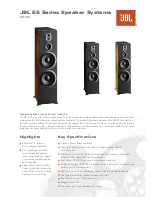
the drywall section can be replaced clean-
ly if there is an unseen obstruction behind
the wall. BE VERY CAREFUL NOT TO
SAW THROUGH EXISTING WIRES, PIPES,
OR STRUCTURE. IF YOU FEEL ANY
EXTRA RESISTANCE AS YOU ARE CUT-
TING, STOP.
4. If you are cutting into lath and plaster
walls, use masking tape to outline your
penciled marks, drill the four corners with
a 1/4” bit and use a razor to score the
plaster down to the lath beneath. Then use
a chisel to remove all of the plaster within
the taped outline. Finally, insert a metal
cutting blade into a sabre saw and very
slowly and carefully saw the lath. Sawing
the lath can easily vibrate plaster off the
wall. If you have the patience, use a pair
of tin snips to slowly nip away at the lath
instead. There is no risk with this method,
it is just time consuming.
5. Fill the wall cavity with insulation at
this point. Remember to use equal
amounts of insulation for each speaker.
6. Slip the mounting bracket through the
hole and pull it toward you so that its front
edge slides into the hole and stops in
place.
7. Attach the frame to the bracket by
screwing the frame to the bracket using
the supplied screws. Do not overtighten
the screws, this will distort the frame and
the grilles will not fit (this is not perma-
nent, just loosen the screws and the grille
will pop in). The screws should pull the
frame and bracket together (sandwiching
the drywall) so that the frame is absolutely
flush with the wall surface. There should
be no gaps between the wall and the
frame
(See Figure 12)
.
Installation of the
Speaker and Grille
in New or Existing
Construction
Setting the Acoustic Fine Tuning
Setting the switch located on the rear of
the loudspeaker to the “
NORMAL
” or
“
PRESENCE
” position changes the overall
tonal character of the sound.
The speaker is shipped in the “
NORMAL
”
position. This is most appropriate for
rooms with typical reflective painted or
wallpapered walls and ceilings, and nor-
mal amounts of furniture and drapes. You
might prefer the “
PRESENCE
” position if you
are placing the speaker in a very large, or
very absorbent room (lots of drapes and
upholstered furniture or textured fabric
wallpaper).
Installing a Niles MS-1 MicroSensor™
There is a 1/2" round molded "IR Sensor
Knockout" on the face of the speaker baf-
fle. To prevent damage to the crossover
network you must remove the knockout
from the rear of the speaker. Do not
attempt to remove the knockout with the
speaker face up. Lay the speaker face
down on a clean carpet or rug. Put the tip
of a screwdriver into the center of the
round "knockout" and sharply tap the
screwdriver handle as necessary. Install
the MS-1 using its mounting hex nut so
that it is tightly secured to the speaker.
Connect all wires and continue your
installation.
16
Inst
allation
of
the Speak
er and Grille in Ne
w or Existing Constr
uction







































